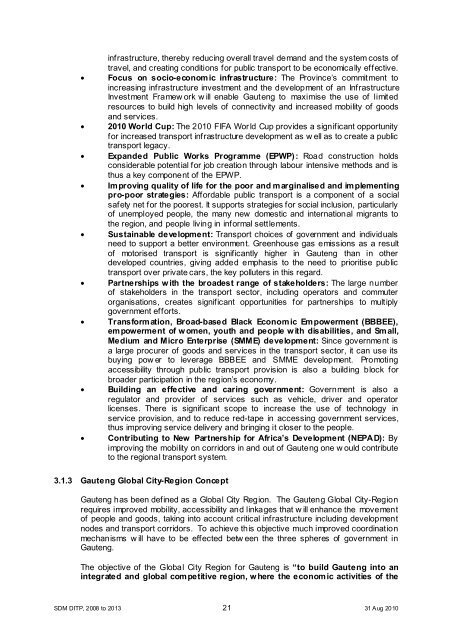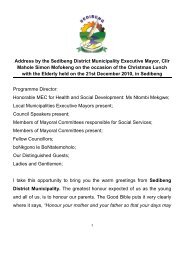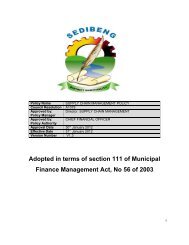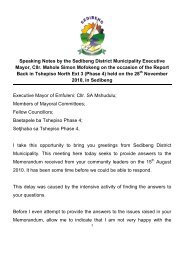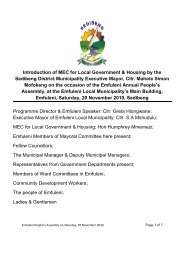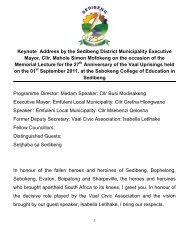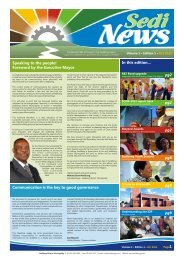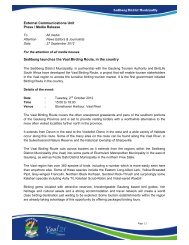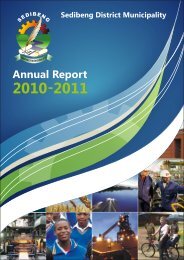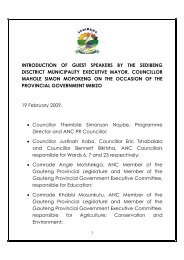Chapter 11 - Sedibeng District Municipality
Chapter 11 - Sedibeng District Municipality
Chapter 11 - Sedibeng District Municipality
You also want an ePaper? Increase the reach of your titles
YUMPU automatically turns print PDFs into web optimized ePapers that Google loves.
infrastructure, thereby reducing overall travel demand and the system costs of<br />
travel, and creating conditions for public transport to be economically effective.<br />
• Focus on socio-economic infrastructure: The Province’s commitment to<br />
increasing infrastructure investment and the development of an Infrastructure<br />
Investment Framew ork w ill enable Gauteng to maximise the use of limited<br />
resources to build high levels of connectivity and increased mobility of goods<br />
and services.<br />
• 2010 World Cup: The 2010 FIFA World Cup provides a significant opportunity<br />
for increased transport infrastructure development as w ell as to create a public<br />
transport legacy.<br />
• Expanded Public Works Programme (EPWP): Road construction holds<br />
considerable potential for job creation through labour intensive methods and is<br />
thus a key component of the EPWP.<br />
• Improving quality of life for the poor and marginalised and implementing<br />
pro-poor strategies: Affordable public transport is a component of a social<br />
safety net for the poorest. It supports strategies for social inclusion, particularly<br />
of unemployed people, the many new domestic and international migrants to<br />
the region, and people living in informal settlements.<br />
• Sustainable development: Transport choices of government and individuals<br />
need to support a better environment. Greenhouse gas emissions as a result<br />
of motorised transport is significantly higher in Gauteng than in other<br />
developed countries, giving added emphasis to the need to prioritise public<br />
transport over private cars, the key polluters in this regard.<br />
• Partnerships w ith the broadest range of stakeholders: The large number<br />
of stakeholders in the transport sector, including operators and commuter<br />
organisations, creates significant opportunities for partnerships to multiply<br />
government efforts.<br />
• Transformation, Broad-based Black Economic Empowerment (BBBEE),<br />
empowerment of w omen, youth and people w ith disabilities, and Small,<br />
Medium and Micro Enterprise (SMME) development: Since government is<br />
a large procurer of goods and services in the transport sector, it can use its<br />
buying pow er to leverage BBBEE and SMME development. Promoting<br />
accessibility through public transport provision is also a building block for<br />
broader participation in the region’s economy.<br />
• Building an effective and caring government: Government is also a<br />
regulator and provider of services such as vehicle, driver and operator<br />
licenses. There is significant scope to increase the use of technology in<br />
service provision, and to reduce red-tape in accessing government services,<br />
thus improving service delivery and bringing it closer to the people.<br />
• Contributing to New Partnership for Africa’s Development (NEPAD): By<br />
improving the mobility on corridors in and out of Gauteng one w ould contribute<br />
to the regional transport system.<br />
3.1.3 Gauteng Global City-Region Concept<br />
Gauteng has been defined as a Global City Region. The Gauteng Global City-Region<br />
requires improved mobility, accessibility and linkages that w ill enhance the movement<br />
of people and goods, taking into account critical infrastructure including development<br />
nodes and transport corridors. To achieve this objective much improved coordination<br />
mechanisms w ill have to be effected betw een the three spheres of government in<br />
Gauteng.<br />
The objective of the Global City Region for Gauteng is “to build Gauteng into an<br />
integrated and global competitive region, w here the economic activities of the<br />
SDM DITP, 2008 to 2013 21 31 Aug 2010


